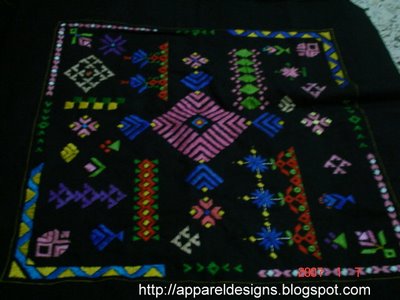Phulkari embroidery
Phulkari is splendidly ornamented by a continuous design through skillful handling of darning.
Chobes is another type of Phulkari in which the edges alone are ornamented with the center being left plain.

The beauty of Phulkari is enhanced by the color of the ground material.
The thread used is invariably pure silk. The uniqueness of the Phulkari embroidery is that its long short darning stitches are worked on the wrong side of the cloth. However, the pattern takes shape on the right side
Fabric Used:
The beauty of Phulkari depended a great deal on the colour of the ground material. Khaddar cloth which was hand spun and hand woven cotton material, was always used for embroidery. The colour was mostly red, white, blue or black.
Threads Used:
The thread used was pure silk. It is untwisted silken floss called PAT.
Golden yellow, green, white, crimson red and orange are the five colours prepared in selecting silk floss for Phulkari work.
Motifs Used:
The motifs are made up of horizontal, vertical and diagonal stitches, producing geometric pattern in Phulkari designs while the Baugh has an overall geometrically floral pattern.
Stitches Used:
The stitch craft of Phulkari consists long short darning stitches. It is a unique method of embroidery in that it is worked entirely on the wrong side of the cloth and the pattern takes shape on the right side. The design is neither drawn nor traced.
Kinds of Phulkari Embroidery:
There are many types of Phulkari.
The 'Chope' and 'Suber' were wedding Phulkari presented to bride by her maternal relations during the marriage ceremony.
The plain red / dark red khaddar shawl known as 'Saloo' was used for daily household wear.
'Til Patra' shawls have very little embroidery and are inferior quality Khaddar.
'Nilak' is worked on black or navy blue Khaddar with yellow and crimson red pat. | Embroidery | Embroidery designs | Embroidered clothing | zardosi embroidery | Kutch embroidery | kantha embroidery |


0 Comments:
Post a Comment
<< Home